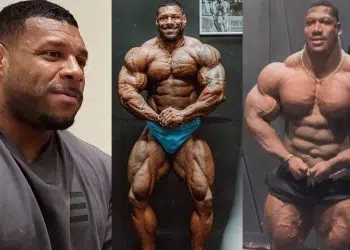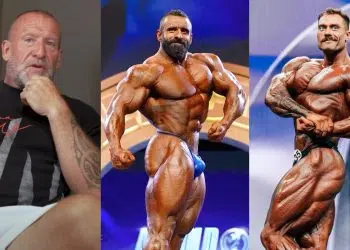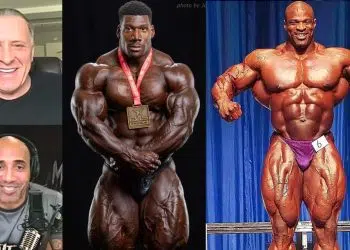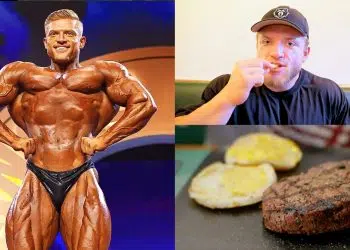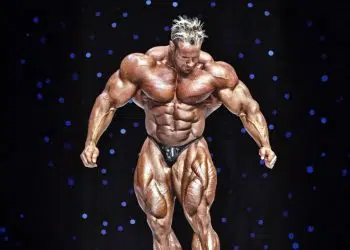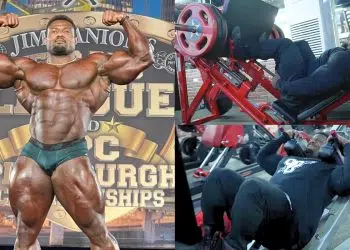Of all the muscle groups in the human body, the posterior chain is arguably one of the most important. The posterior chain, which is the collective term for your hamstrings, glutes, and lower back, drives almost all of your movements, from walking to running to lifting to jumping.
As well as being important for performance, the posterior chain plays a critical part in supporting and protecting your lower back from stress and strain. In fact, a study published on PubMed suggests that improving posterior chain strength is an effective way to reduce the severity of some forms of back pain (1).
In my role as a 30-year veteran personal trainer, I ensure all my clients do plenty of posterior chain training. This, I have found, makes a huge difference to everything from posture to athletic performance to aesthetics.
While there are lots of great posterior chain exercises to choose from, reverse hyperextensions are one of the best. Also known as known as reverse hypers, this exercise comes from the world of powerlifting but is now widely accepted as an excellent general strength, conditioning, and bodybuilding exercise.
In this article, I explain how to do reverse hyperextensions and reveal the benefits, best variations, and alternatives.
How to Do the Reverse Hyperextension
To do reverse hypers, you’ll need a reverse hyperextension machine. Don’t worry if your gym hasn’t got one of these – there are alternatives later in this article.
Level Up Your Fitness: Join our 💪 strong community in Fitness Volt Newsletter. Get daily inspiration, expert-backed workouts, nutrition tips, the latest in strength sports, and the support you need to reach your goals. Subscribe for free!
- Lie face down on the reverse hyper machine. While your upper body and stomach should be on the bench, your hips should not. This will allow them to move freely.
- Let your legs hang straight down toward the floor. Hold the handles to keep your upper body in position. Brace your abs to keep your spine stable and supported.
- Lift your legs by contracting your hamstrings, glutes, and lower back. Keep them straight. Raise them until they are roughly parallel to the floor.
- Lower your legs and repeat.
Most reverse hyper machines allow you to increase the load on the target muscles. Some have lever arms and ankle pads to which you can add weight plates. Others are connected to weight stacks or have ankle cuffs and cables. It all depends on the design of the machine you are using. For safety and effectiveness, always follow the manufacturer’s instructions.
Tips:
- Lift the weight smoothly to avoid momentum and keep the tension on the target muscles.
- Take care not to raise your legs too high, as doing so puts excess strain on your lower back.
- Start light and increase the weight gradually to avoid injury.
- Make sure you push back with both legs evenly to avoid left-to-right strength or muscle size imbalances.
Reverse Hyperextensions – Muscles Worked
We’ve already briefly mentioned the muscles used during reverse hypers. However, it’s worth delving a little deeper into the anatomy of this exercise so that you have a better understanding of why this exercise is so beneficial.
The main muscles used during reverse hypers are:
Erector Spinae – also known as your spinal erectors, these muscles run up either side of your back. Their primary job is the extension of your spine, but in reverse hypers, their main role is keeping your lower back fixed and stable as you lift your legs. Erector spinae activation is much lower than in exercises like Romanian deadlifts and regular hyperextensions.
Gluteus Maximus – called your glutes for short, this is the largest muscle in the human body. Located on the back of your hip and pelvis, your glutes are responsible for hip extension. Stronger glutes can help you run faster and jump higher.
Hamstrings – located on the back of your thigh, your hamstrings have two functions. They are responsible for knee flexion, a function best trained by doing leg curls. They also work alongside your glutes in hip extension.
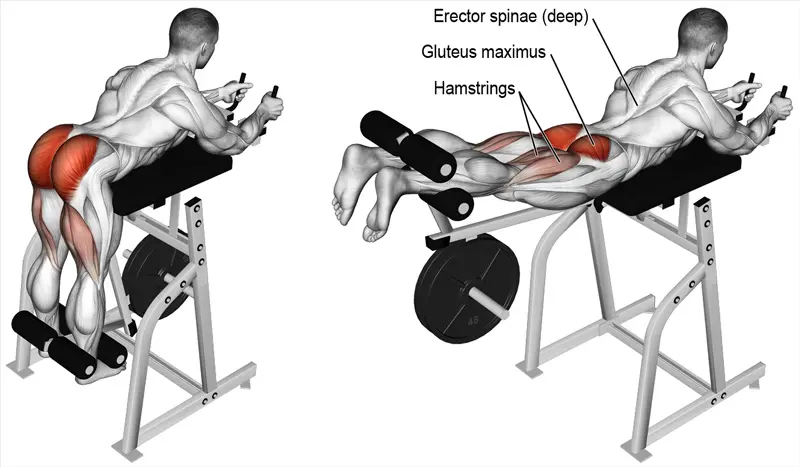
Reverse Hyperextension Benefits
There are several important reasons that reverse hypers deserve a place in your workouts.
Less low back strain – when you do exercises like Romanian deadlifts, 45-degree back extensions, and regular deadlifts, your lower back is completely unsupported. This can put a lot of strain on your spine. While this isn’t always a problem, if you have a sore, tired, or injured lower back, you may not want to do these exercises.
Reverse hypers work your posterior chain without a whole lot of movement or strain on your lower back. Performed correctly, your lower back should remain stationary, which means there is less wear and tear, and a lower chance of injury (2).
Whether you have back pain or just want to avoid it, the reverse hyper means you can train your posterior chain much more safely.
More powerful hip extension – the main movement in reverse hypers is hip extension. Hip extension is a fundamental movement pattern. Running, jumping, and kicking all feature hip extension. If you are an athlete in any sport, increasing hip extension power will be very beneficial. A stronger hip extension will also improve your squat and deadlift performance.
Better-looking glutes – there is absolutely nothing wrong with working out to look better. In fact, this is a major goal for many exercisers. The reverse hyper is a very effective way to target your glutes, giving you a firmer, more shapely butt. For this reason, reverse hypers are very popular with fitness models and anyone else looking to put more “junk in their trunk”
Injury prevention – most posterior chain exercises feature a pronounced hip hinge. A hip hinge involves bending forward at the hips but without rounding your lower back. A rounded lower back is weak and very prone to injury. People round their lower backs during training for several reasons, including poor core strength, tight hamstrings, using too much weight, and simply not knowing any better.
Lying face down on a hyperextension bench makes it almost impossible to round your lower back. This makes reverse hypers much safer and ideal for injury prevention (3).
Programming Reverse Hyperextensions
To get the most from reverse hypers, make sure your weight and reps match your training goals. Use the following guidelines to address the type of fitness you want to develop with this exercise.
- For power and strength: 4-6 sets of 3-5 reps using heavyweights. Rest 2-3 minutes between sets.
- For hypertrophy (muscle size): 3-5 sets of 6-12 reps using moderate to heavy weights. Rest 60-90 seconds between sets.
- For muscular endurance: 2-4 sets of 13-20 reps using light to moderate weights. Rest 30-60 seconds between sets.
Reverse Hyperextension Variations
While the reverse hyper is a great exercise, it can soon become boring if you always use the same variation. Here are a few ways to mix up your reverse hyperextension workouts and keep things fresh and interesting.
Single-Leg Reverse Hyperextensions
Regular reverse hypers are a bilateral exercise, meaning they work both legs at the same time. While this is a good option for most people, it can cause or disguise left-to-right strength imbalances in others. Also, most athletic and strenuous everyday activities happen one leg at a time, like running or climbing stairs.
As such, the single-leg reverse hyperextension is an excellent variation for anyone looking for a more functional, balanced posterior chain workout. Use it to fix your left-to-right strength imbalances, or avoid them in the first place.
How to do it:
- Lie face down on the reverse hyper machine. While your upper body and stomach should be on the bench, your hips should not. This will allow them to move freely.
- Let one leg hang straight down toward the floor and position the other so it’s out of the way.
- Hold the handles to keep your upper body in position. Brace your abs to keep your spine stable and supported.
- Lift your leg by contracting your hamstrings, glutes, and lower back. Keep your leg relatively straight and raise it until they roughly parallel to the floor.
- Lower your leg and repeat.
- Switch sides and do the same number of reps with the opposite leg.
Paused Reverse Hyperextensions
Paused reps are one of the best ways to overload your muscles without adding lots of extra weight. Pausing when your muscles are fully contracted increases tension and creates more metabolic stress within the posterior chain. You’ll especially feel this variation in your glutes.
You can do paused reverse hyperextension with or without weights. If you choose to load them, be aware that a little weight goes a long way; this is a demanding exercise that’s perfect for experienced lifters.
How to do it:
- Climb aboard your reverse hyper machine so your hips are on the edge of the bench. Hold the handles and brace your core to stabilize your spine. Let your legs hang straight down.
- Without swinging or kicking, raise your legs up until they’re roughly parallel to the floor. Hold this position for 2-5 seconds. The longer you pause, the more challenging this exercise becomes.
- Smoothly lower your legs and repeat.
Reverse Hypers on a Glute-ham Developer (GHD)
GHDs are benches on which you can do a sort of back extension/leg curl combination. You can also turn over and do an ultra-tough sit-up variation. GHD benches can be used to do reverse hyperextensions, too. You’ll find GHD benches in most CrossFit boxes and functional gyms.
Level Up Your Fitness: Join our 💪 strong community in Fitness Volt Newsletter. Get daily inspiration, expert-backed workouts, nutrition tips, the latest in strength sports, and the support you need to reach your goals. Subscribe for free!
How to do it:
- Stand at the head end of the GHD with your hips up against the pad. Lean forward and grab the handles next to the leg restraints, or the sides of the footplate/leg restraints themselves.
- Keeping your legs straight, use your posterior chain muscles to lift them up until they are parallel to the floor. Lower them back down and repeat.
- Make this exercise harder by wearing ankle weights or attaching a resistance band to the GHD and putting your feet inside the loop. Alternatively, grip and hold a medicine ball between your ankles.
Banded Reverse Hyperextensions
Resistance bands are a great alternative to lifting weights. You can use a good set of bands to replicate most freeweight and machine-based exercises, making them ideal for home workouts and while traveling. In addition, band exercises often have a different feel to their weighted counterparts, making them an ideal way to add variety to your workouts.
You can use bands instead of weights on regular reverse hyperextension machines, or when doing reverse hypers on a glute-ham developer.
How to do it:
- Attach a loop-type resistance band to whatever equipment you’re using for reverse hypers.
- Set up for reverse hyperextension as usual. Place the band around your ankles, brace your core, and grip the handles for stability.
- Smoothly lift your legs until they’re roughly parallel to the floor. Note how the tension increases as you extend your hips.
- Lower your legs under control and repeat.
Reverse Hyperextensions Using a Gym Bench
No reverse hyper machine GHD bench at your gym? No problem! You can also do a version of reverse hyperextensions using a regular gym bench.
How to do it:
- Lie face down on a gym bench, so your upper body is on the bench, and your legs are straight, feet resting on the floor. While your chest and abdomen should be on the bench, your hips and pelvis should be just off the end.
- Keeping your legs straight, lift your legs up until they are parallel to the floor, and then lower them back down. Do not overextend your lower back.
- Increase the range of motion and, therefore, the difficulty of the exercise by raising your bench up on blocks or steps. Make sure the bench is stable and won’t topple during use.
Reverse Hypers Using a Stability Ball
If you exercise at home, you may be thinking that reverse hypers are not for you. The good news is that if you have a stability ball, you can do a version of this exercise even if you don’t train at a gym.
How to do it:
- Lie face down on a stability ball. The larger the ball, the more effective the exercise will be. Place your hands on the floor or, alternatively, grab hold of an immovable object. The ball should be under your abdomen and hips.
- Keeping your upper body stationary, lift your legs up off the floor until they form a straight line with your body.
- Lower your feet back to the floor and repeat.
You can also place and hold a stability ball on an exercise bench to do reverse hypers. This provides a larger range of motion and will also help develop your balance.
Reverse Hyperextension Alternatives
As effective as reverse hyperextensions are, they’re not the only way to strengthen your posterior chain. As an experienced personal trainer, I like to have access to a comprehensive library of exercises for each body part. That way, I always have plenty of options to meet my client’s needs and goals.
To that end, here are some of the best reverse hyperextension alternatives, each one working the same posterior chain muscles.
Barbell Romanian Deadlift
As much as I love reverse hypers, I probably love barbell Romanian deadlifts more. There is something so natural about holding a barbell in your hands, and you can do this exercise with heavy weights to build brute strength. However, they are harder on your lower back than reverse hyperextension, which is what makes reverse hypers so valuable.
How to do it:
- Hold a barbell in front of your legs using an overhand or mixed shoulder-width grip.
- Stand with your feet hip-width apart and your knees slightly bent. Pull your shoulders back and down and brace your core.
- Push your butt back and hinge forward from your hips. Lower the barbell down the fronts of your legs, taking care not to round your lower back.
- Drive your hips forward and stand back up. Do not lean backward, as doing so increases your risk of injury.
- Continue for the desired number of reps.
Find out more about Romanian deadlifts in this detailed article.
Barbell Good-Morning
The barbell good-morning is so-called because, when you do it, you look like you are bowing politely to greet someone. However, don’t let this genteel-sounding name confuse you; this is a very demanding posterior chain exercise. Consequently, you should start light and only increase the weight when you are confident you have mastered perfect form.
How to do it:
- Rack and hold a barbell across your upper back, as if you are about to do squats. Stand with your feet between shoulder to hip-width apart, knees slightly bent. Brace your core.
- Hinging from your hips, push your butt back and lean forward as far as your flexibility allows. Do not round your lower back.
- Drive your hips forward and stand back up.
- Continue for the prescribed number of reps.
Learn more about good mornings, including the best variations, in this comprehensive guide.
Barbell Hip Thrust
Like the reverse hyperextension, the barbell hip thrust is a very lower back-friendly posterior chain exercise. Because you need no special equipment, it’s also an accessible exercise that most people can perform. However, when you use moderate to heavy weights and push your muscles to failure, you’ll discover that this is a very powerful exercise for building a stronger and more muscular posterior chain.
How to do it:
- Sit on the floor with your legs bent and feet flat. Rest shoulders against a sturdy bench. Place and hold a barbell across your hips. Brace your core.
- Drive your feet into the floor and lift your hips up so they form a straight line with your knees and shoulders.
- Lower your butt back to the floor and repeat.
Discover more about barbell hip thrusts in this in-depth guide.
Glute-Ham Developer Raise
I’ve already talked about how you can use a glute-hamstring developed (GHD) to perform reverse hyperextension However, this exercise is also a great alternative to reverse hypers. However, it’s a pretty challenging exercise, so you may need to work up to this one if you are unused to working your posterior chain.
How to do it:
- Adjust the foot platform so that your hips are entirely off the support pads during the exercise.
- Get on the GHD machine and place your feet between the foot pads. Your feet should be pointing straight down during the exercise.
- Cross your arms in front of your chest.
- Lower your torso toward the floor so that your body is vertical. Again, your hips should be off the pads. This will be your starting position.
- Take a deep breath, brace your core, and lower your torso until it is almost perpendicular to the floor.
- Contract your glutes and return to the starting position.
- Repeat for the desired number of reps
Learn more about GHD raises in this comprehensive guide.
Reverse Hyperextensions – FAQs
Do you have a question about reverse hypers, or posterior chain training in general? No problem, because I’ve got the answer. Alternatively, if you need more information, please drop me a line in the comments section below, and I’ll get back to you ASAP.
1. How often should I do reverse hyperextension?
Despite being relatively lower back-friendly, reverse hyperextensions are still a pretty strenuous exercise. As such, you should only do them 1-2 times per week. More than that, and you risk injury and overtraining. If you do them twice weekly, I suggest separating your workouts by several days, e.g., Monday and Thursday.
2. Are reverse hyperextension safe?
Reverse hyperextensions are relatively safe. They don’t put too much load on your lower back, and there are no heavy weights to drop on yourself if you are unable to complete a rep. That said, using too much weight or slopping form could open you to injury.
Avoid such issues by increasing your weights gradually and never sacrificing good form for more load or reps.
3. Are reverse hyperextensions the best posterior chain exercise?
I don’t believe that there is a best exercise for the posterior chain. That’s because there are so many great movements to choose from! Ultimately, the best exercise is the one that suits you and provides the results you want. For some, that could be reversed hypers, but for others, the best exercise could be Romanian deadlifts or good mornings.
I suggest you try a few different exercises to see which ones produce the results you want. Even then, doing a few different exercises is arguably the best way to avoid training ruts and create a more balanced workout.
4. Aren’t reverse hyperextensions just for powerlifters?
While reverse hypers came from powerlifting, other exercisers can benefit from them, too. Regardless of your training goal, if you want a stronger posterior chain, adding reverse hyperextensions to your workouts will help you achieve it. As such, it’s suitable for all types of exercisers, and not just powerlifters.
5. Can you do reverse hyperextensions at home?
While the most common way to do reverse hypers is with a dedicated reverse hyperextension bench, there are several ways you can do this exercise without one, making it suitable for home workouts, too.
You can do reverse hypers using a tabletop, a regular exercise bench, or a stability ball. Provided you can rest your upper body flat, and your legs are free to move, you should be able to replicate reverse hyperextensions at home.
Conclusion
Even if you don’t have a reverse hyperextension machine at your gym, you can still do this great glute, hamstring, and lower back exercise. It’s easy on your lower back but still a very effective exercise. Whether you are training for fitness, increased strength, bigger muscles, or improved sports performance, reverse hyperextensions can help you reach your goals faster and more safely.
References:
1 – Tataryn N, Simas V, Catterall T, Furness J, Keogh JWL. Posterior-Chain Resistance Training Compared to General Exercise and Walking Programmes for the Treatment of Chronic Low Back Pain in the General Population: A Systematic Review and Meta-Analysis. Sports Med Open. 2021 Mar 8;7(1):17. doi: 10.1186/s40798-021-00306-w. PMID: 33683497; PMCID: PMC7940464.
2 & 3 – Lawrence, Michael A.; Chin, Andrew; Swanson, Brian T. (2019-08). “Biomechanical Comparison of the Reverse Hyperextension Machine and the Hyperextension Exercise”. Journal of Strength and Conditioning Research. 33 (8): 2053–2056. doi:10.1519/JSC.0000000000003146. ISSN 1533-4287. PMID 30946266.


